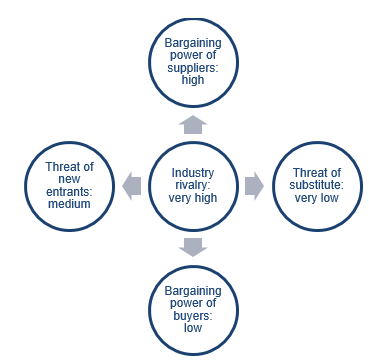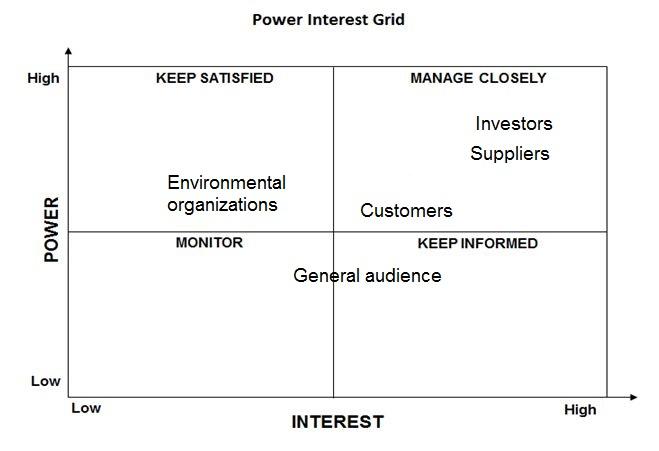Locating the Target Market and Working on the Competitive Advantage
BP has been known as a large organization at the helm of the UK energy market (Grant 2016). The firm is considered to have huge potential for a reason; incorporating innovative approaches in managing its internal processes, it promotes the concept of accountability as the foundation for the interactions between the managers and employees. Nevertheless, the company needs to make changes to its current design because of the economic and social challenges that it has faced over the past few years because of its wrong decisions. Primarily, the environmental issue has to be addressed scrupulously and carefully. The fact that the organization is reaching its maturity also needs to be listed among the crucial arguments in favor of its restructuring (Grant 2016).
The market in which the company works incorporates an array of factors that complicate the process of the company’s operations, with the environmental problems topping the list of the burning issues. As the PESTLE analysis provided below shows, the company has been affected significantly by the negative reviews received after causing oil spills (Chang, Stone, & Demes 2015).
Figure 1. BP PESTLE Assessment.
Similarly, the current demands toward up- and downstream technology and its quality pose an array of challenges to BP. Although the organization claims that it prides itself on the technological advances used in oil drilling, the infamous cases of oil spills point directly to the lack of high-quality equipment. Furthermore, the lawsuits that have been filed by the people and companies damaged by the oil spills serve as barriers to the company’s success. However, after a recent shift of the firm’s attention to sustainable operations, an improvement in its technology and a rise in environmental awareness are expected. The absence of political constraints coupled with a significant influence on the global economy gives hope for a revival of BP as a powerful and successful company.

As the Five Forces analysis shows, the competitive rates in the industry make it quite difficult for BP to climb to the top of the market. The challenge became especially tough after BP had taken the blame for the oil spills. Low bargaining power of buyers, however, allows for maintaining the high-profit margins. It should be borne in mind, though, that the threat of new companies appearing in the global economic environment and taking over the industry is becoming increasingly more tangible. Given the number of technological opportunities, including the up- and downstream-related processes, new entrants may enjoy many possibilities for rapid economic growth. To create a competitive advantage that will help the firm survive in the contemporary realm of the oil and gas industry, a tremendous effort must be made.
Key Stakeholders, Their Concerns, and the Strategies for Addressing Them
Being a participant of not only the British energy market but also the global one, BP has many shareholders (BP: its 10 biggest shareholders 2010). Despite the recent drop in shares, the firm still has some of the world’s renowned organizations among its shareholders. The latter include BlackRock, Legal&General, Barclays Global Investors, Norges Bank Investment Management, etc. (BP: its 10 biggest shareholders 2010).
However, investors are only a part of the stakeholders whose needs the firm must cater to. A recent report on the change in the company’s policy and the shift toward sustainability highlights the fact that BP views the people and the organizations affected by its operations, including oil drilling contractors, as the primary stakeholders: “We discussed challenges the industry faces in improving safety performance with around 25 of our drilling contractors and wells service providers at our annual global wells organization safety workshop” (BP, 2016).
Nevertheless, the damage to BP’s reputation, which occurred after the notorious oil spills, is likely to hurt the firm’s economic growth unless an awareness campaign is designed to invite the stakeholders to view the changes to BP’s design and its focus on sustainability (see Fig. 3).

As the grid above shows, there is a consistent need to keep investors, customers, and suppliers informed. Investors and customers are the primary sources of BP’s concern since they define the financial performance of the firm. Similarly, suppliers, as the organizations of comparatively high power in the oil industry, also need attention.
The relationships with the key stakeholders, including suppliers, investors, contractors, and related organizations, can be improved by altering the code of conduct that is currently accepted at BP as the appropriate one. By “enhancing both ecological and human capabilities” (Li, Zhu, & Lu 2014, p. 56), BP will be able to convince its stakeholders that it is worth trusting and that the environmental issues are a thing of the past.
To establish a better presence in the target market, BP will have to bring all available data management tools into play. For instance, the firm should consider using social networks as the means of spreading the word about its recent change and its environmentally friendly approach. Besides changing the attitude of the general audience toward the company and its operations, BP will also have to convince its suppliers and partners that its profit margins are not going to shrink.
Investors must also be aware of the fact that the firm is worth its resources. Last but not least, organizations concerned with BP’s impact on the environment must also be reached. Meetings and conference calls can be used to contact the stakeholders, such as business partners and concerned institutions, directly, whereas the general audience can be reached with the help of newsletters. Events can be arranged to attract the attention of environmental organizations. The message about the change toward sustainability will have to be delivered within the next two to three months so that the firm can recover quickly and proceed with its operations.
Company’s Objectives: Promoting Sustainability and Creating Shareholder Value
Because BP has been known for its decisions that have affected the environment to a considerable extent, particularly numerous oil spills, the current focus of the company must be on enhancing sustainability and promoting it as its primary goal. Furthermore, the principle of accountability could be coupled with the notion of Corporate Social Responsibility (BP 2015). To attain the goal of improving its current performance and reputation, BP must become a learning organization. To be more accurate, the company must “learn better than its competitors and apply that knowledge throughout its business faster and more widely than they do” (Grant 2016, p. 519).
Going into further detail, one may suggest that the firm should consider using a wider range of data management tools as well as update its current information management system. Similarly, the staff members’ skills need to be improved so that the employees can retrieve, process, and use the available information about the changes in the target market and the company’s operations to BP’s advantage.
It is also strongly recommended that BP should deploy the models that will help it manage the required changes successfully and improve the communication process in a manner that is as expeditious as possible. For these purposes, two models can be suggested. First and most obvious, the Six Sigma framework created by Thomas Pyzdek (Pyzdek & Keller 2014) to implement changes and enhance progress should be considered as an important tool.
To be more accurate, the DMAIC (Define, Measure, Analyze, Improve, and Control) model has to be viewed as a possible choice. By definition, the strategy is aimed at introducing the concept of continuous quality improvement into the organizational design. As a result, the threats of a reduction in quality rates can be mitigated successfully so that BP can build its competitive advantage.
As soon as the corporate philosophy is changed towards continuous improvement in quality, further adjustments to the corporate strategy need to be considered. As stressed above, it will be necessary to promote the concept of Corporate Social Responsibility (CSR) in the context of the organization as well as reinforce the significance of the corporate ethics among the staff members. Surprisingly, BP is not a stranger to the concept of CSR; according to a recent report, apart from the obvious environmental issues, the company has been complying with the current standards for CSR. For example, the emphasis that BP has been placing on the concept of corporate citizenship as part and parcel of its policies and decision-making processes needs to be mentioned as one of the strongest aspects of its philosophy (BP 2015).
The design of a crisis communication strategy that will help the company recognize its fault and address the needs of the affected population should be viewed as the first step toward improving BP’s reputation. At the same time, the organization’s leaders must emphasize the fact that they have learned their lessons and are ready to make amends. Finally, BP must outline the progress that has been made so far in mitigating the outcomes of the oil spills and the lessons that have been learned. As soon as BP proves that it will not make the same mistake once again, it will regain its position in the oil market and the ability to attract new customers successfully.
Reference List
BP. 2015. Sustainability report. Web.
BP. 2016. Our stakeholders. Web.
BP Global. 2015. Press BP energy outlook 2035. Web.
BP: its 10 biggest shareholders. 2010. Web.
Chang, SE, Stone, J, & Demes, K. 2015. ’Consequences of oil spills: a review and framework for informing planning’. Ecology and Society, vol. 19, no. 2, pp. 26-50.
Garcia-Herrero, A & Xu, J. 2016. ‘What consequences would a post-Brexit China-UK trade deal have for the EU?’. Policy Contribution, vol. 1, no. 18, pp. 1-11.
Grant, R M. 2016. Contemporary strategy analysis: text and cases edition. John Wiley & Sons, New York, NY.
Li, S, Zhu, J, & Lu, K. 2014. ‘A case study in strategic sustainability: British Petroleum (BP) Company’. In 3rd International Conference on Information, Business and Education Technology (ICIBET 2014), Atlantis Press, New York, NY, pp. 55-57.
Pyzdek, T & Keller, P. 2014. The Six Sigma handbook. 4th edn, McGraw-Hill, New York, NY.
